Affiliate disclosure: This post may contain affiliate links. Please see our Privacy Policy.
St. Johns Wort tincture is a well-known treatment for mild depression, and there’s evidence that it may help with menopausal symptoms as well. The best part? It’s easy to make at home with just a few simple ingredients.
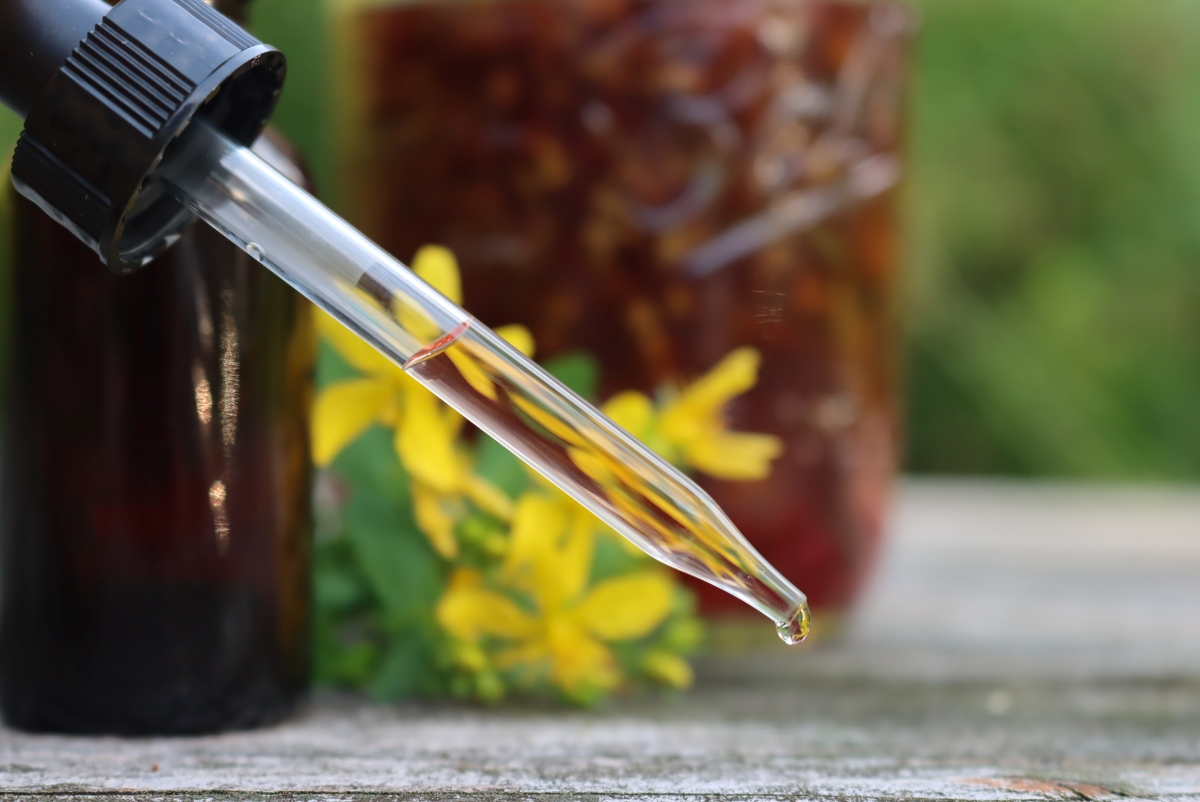
St. John’s wort is getting a lot of press these days as a simple treatment for mild depression, without all the side effects of traditional anti-depressants. Depression has a lot of social stigma surrounding it, or at least it used to, and these days it’s recognized as a natural part of life that happens to almost everyone at some point.
As a good friend of mine like to say, “These days, with all that’s going on in the world, if you’re not a little anxious or depressed sometimes, are you even paying attention?”
Personally, I find the process of making St. John’s Wort Tincture gives me as much of a mood boost as taking it when I’m feeling a bit down. Finding those bright yellow, sunny blossoms means getting outside and opening my eyes to a world of medicine right there for the making.
One of the tricky parts about this tincture, in particular, is that it’s only effective when you use fresh st. johns wort, as the plant rapidly loses its medicinal properties when dried.
With most herbs, dried works just as well as fresh for making herbal tinctures, but not this one. Buying dried st. johns wort is just wasting your money, unfortunately.
Luckily, St. johns wort grows like a weed all over the world, and it’s incredibly easy to identify as well.
(If you can’t find st. johns wort in the wild, you can either buy seeds and grow your own or purchase pre-made St. Johns Wort tincture from a reputable source, like this one, which specifically notes that it’s made with fresh herb instead of dried. Realize that while it’s effective for some people, it’s not a miracle herb, nothing is, and it does have a number of drug interactions and contraindications. Read on for details.)
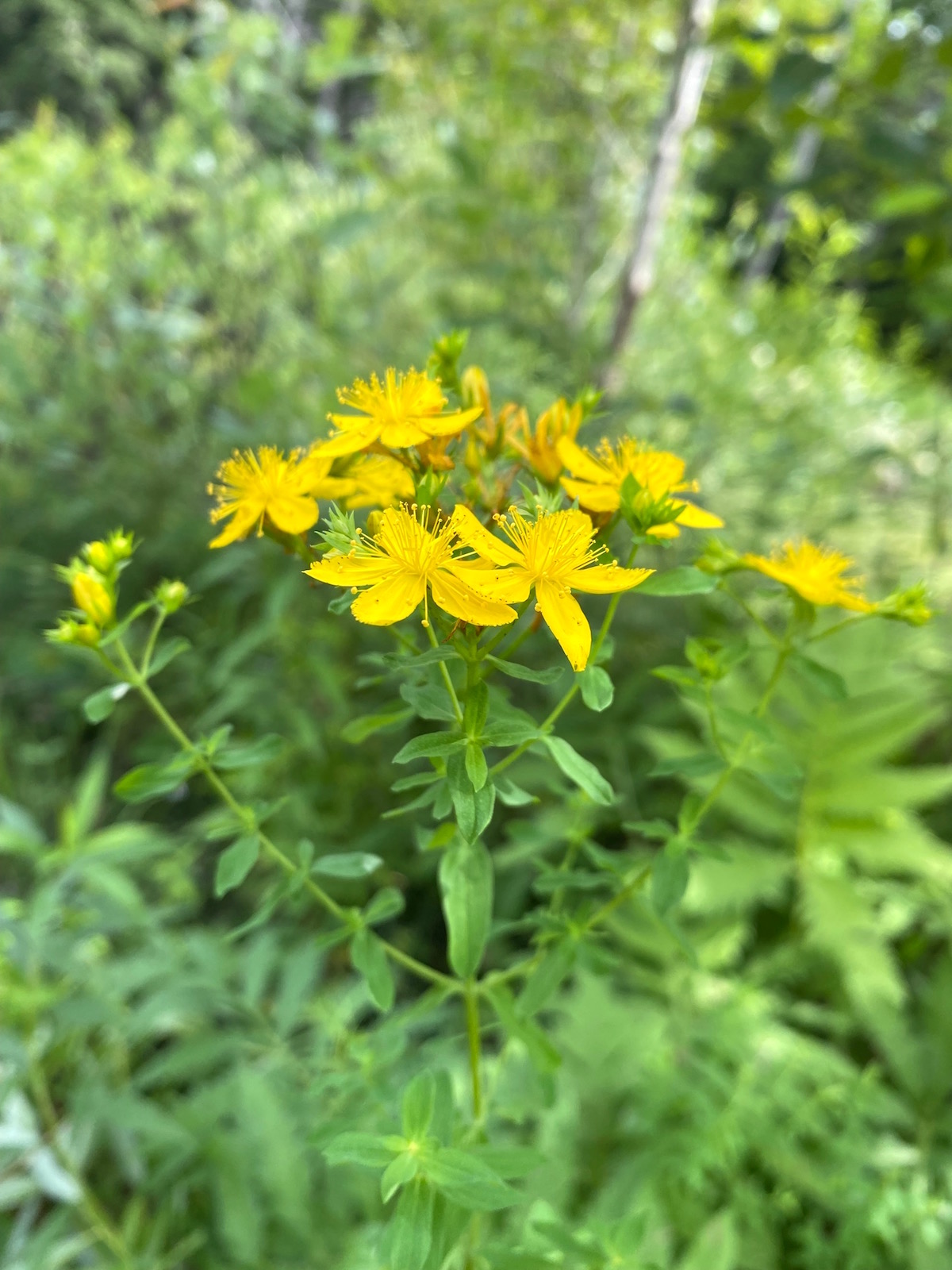
Identifying St. John’s Wort
St. John’s wort was one of the first wild medicinal plants I learned to identify many years ago, back when I was just starting my journey as a herbalist. A friend/mentor plucked a leaf seemingly at random from a roadside plant, and told me to hold it up to the light.
If you look carefully, you can see a number of tiny holes in each leaf. The latin name is Hypericum perforatum, and the “perforatum” part actually refers to the fact that the leaves of the plant are “perforated” or appear to have tiny holes which can only be seen on close inspection.
If you hold a leaf up to the light it becomes particularly dramatic, but the holes are big enough to see even without doing that.
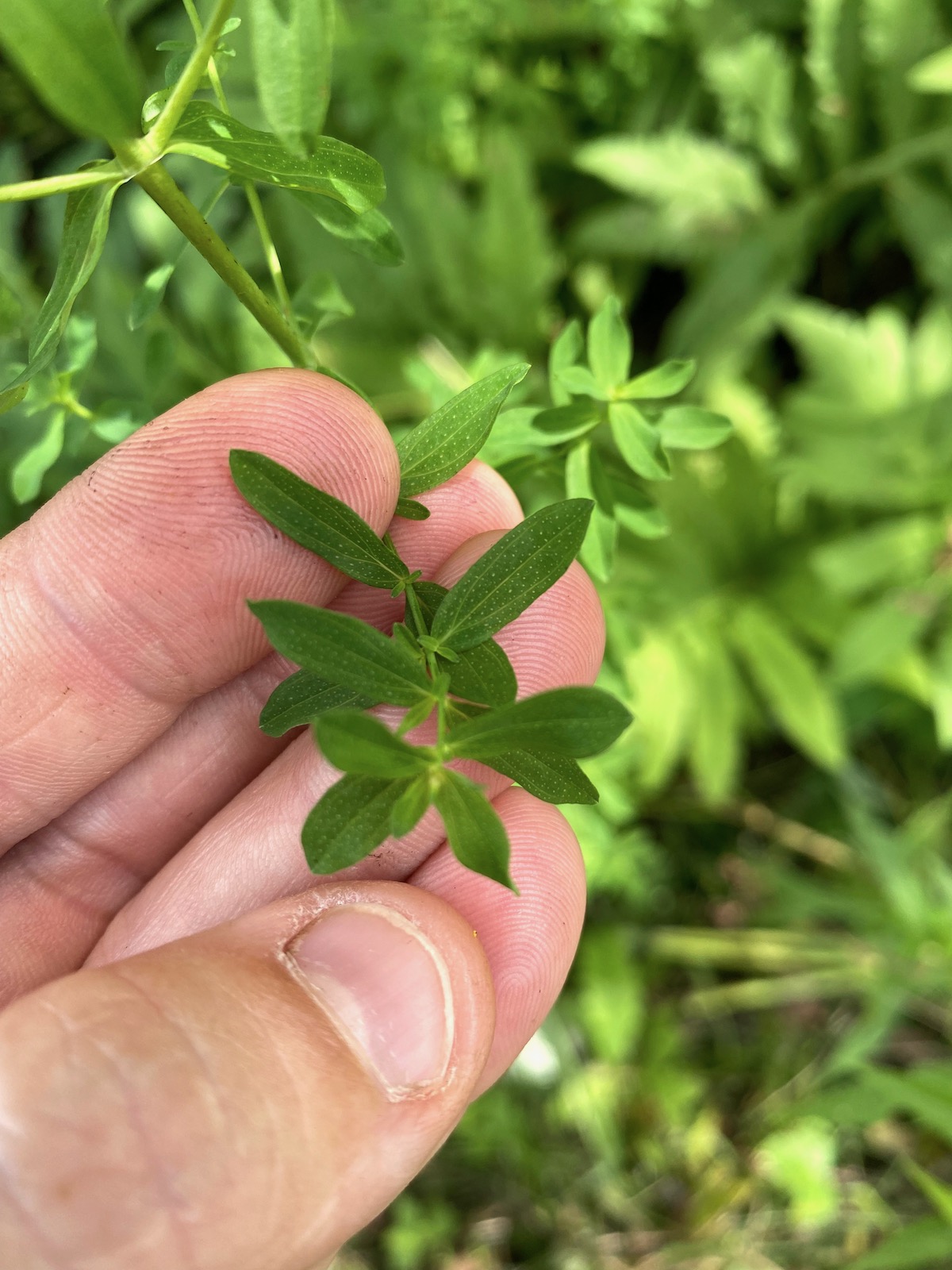
Beyond the leaves, the flowers are a pretty good indicator that you’ve found the right plant. They’re bright yellow, with 5 petals and a lot of tiny pollen-covered stamens bursting out of the center.
My daughter calls it the sunshine plant, and it does look a bit like a sunburst, especially blooming during high summer right at the heat of the year. It almost seems to soak up the sun and radiate it back out.
These bright, sunny flowering tops are what you’ll use to make St. John’s Wort tincture.
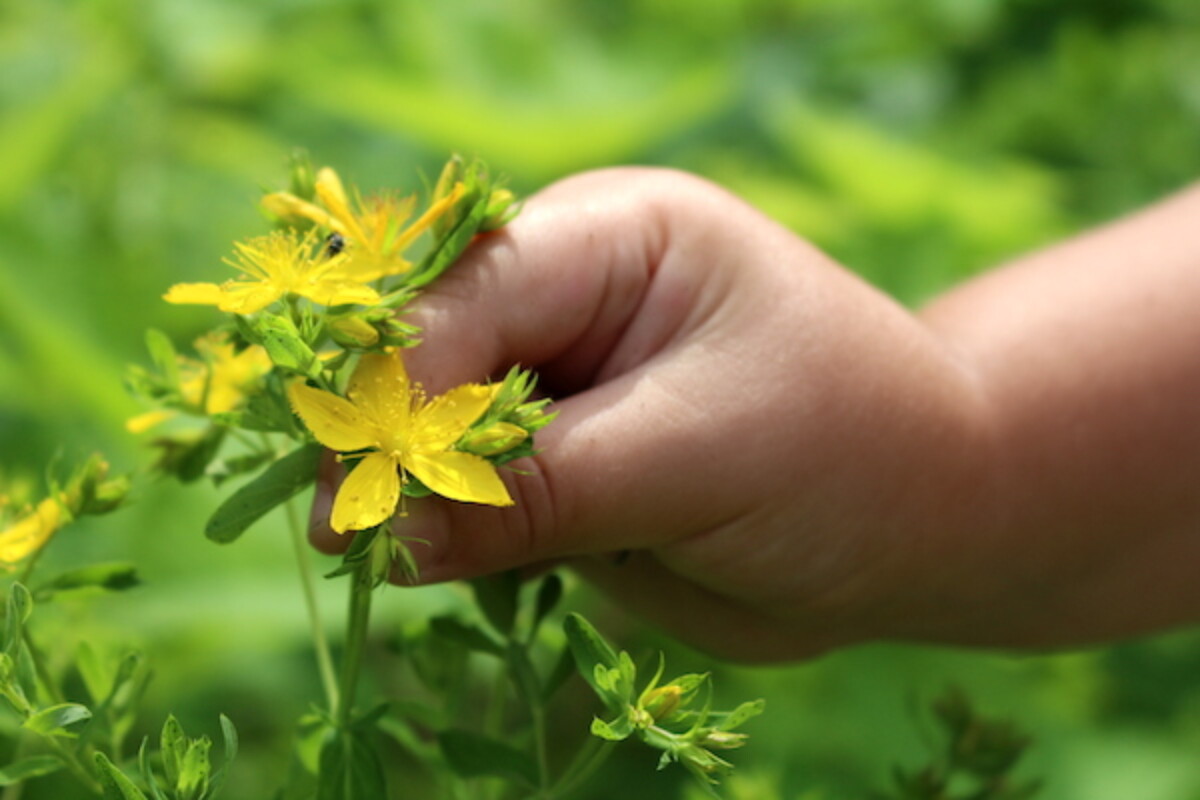
St. John’s wort tends to grow in abused places along roadsides and trails. Spots that get great sunlight, but have low quality, compacted soil. That low-quality soil tends to keep down grassy competition, but they thrive in adversity.
If you’re planting them in your garden, go ahead and put them in your worst garden bed, so long as it gets full sun.
To find them in the wild, just take a walk down any weedy path or road. Obviously try to find the cleanest location you can, as heavily trafficked roads tend to put off a lot of pollution. You’re definitely better off putting in the extra effort to find them along a walking trail rather than a road.
Be aware that there are a few look-alike plants, and I’d suggest consulting my guide to St. John’s Wort plant identification for more details.

(Always consult your doctor or a clinical herbalist before trying any new herbal remedy, as there’s always the possibility of unintended consequences, allergic reaction, or interactions with other medication. If you’re harvesting wild plant material, make sure you’re 100% confident in your identification and consult multiple sources for your ID. The following is based on my research and experience, but I don’t claim to have any certifications that would qualify me to advise you on your health. Please do your own research and always verify with multiple reputable sources.)
Benefits of St. John’s Wort Tincture
You’ll typically find St. John’s Wort mentioned in the context of being a mood-boosting herb; specifically in terms of its ability to lessen symptoms of mild depression. One of the biggest appeals is that, when taken as a tincture, St. John’s Wort doesn’t cause some of the side effects associated with traditional antidepressants.
Keep in mind, if you experience depression, particularly moderate-to-severe depression, it’s worth talking to your doctor about the best option for your specific needs as this herb is not effective for everyone or all types of depression.
It is not sufficient for anything beyond mild depression and can have negative impacts if you have additional issues like bipolar disorder.
There have also been studies that have looked at the effect of St. John’s Wort on pre-menopausal and menopausal women, especially those experiencing both psychological and psychosomatic symptoms. One study found that St. John’s Wort helped not only to diminish these symptoms, it also improved the sexual well-being of the subjects involved.
It’s important to highlight the fact that while St. John’s Wort has been shown to be effective at alleviating symptoms of mild depression and is used to ward of symptoms associated with menopause, there are many types of prescription, life-saving medications that are adversely affected by St. John’s Wort.
It can have negative drug interactions with a long list of common prescription and over-the-counter medications, including:
- Antidepressants (taking St. John’s Wort and an SSRI antidepressant at the same time can cause serotonin syndrome — a serious and sometimes life-threatening drug reaction)
- Hormonal birth control pills
- Heart medications
- HIV medications
- Cancer medications
- Statins
For a complete list of medications that have a negative interaction with St. John’s Wort, check out this helpful resource that goes into St. John’s Wort drug contradictions in greater detail.
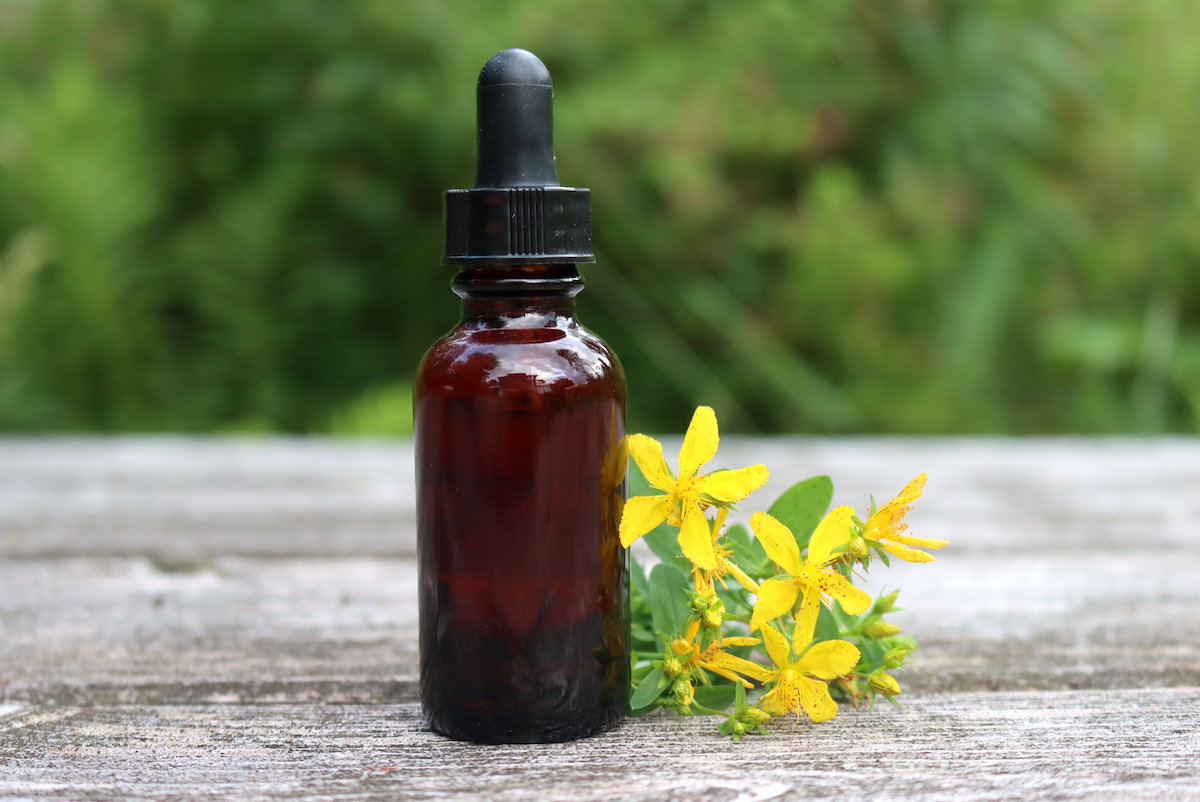
St. Johns Wort Tincture Side Effects
Besides having interactions with a number of modern medications, it also has the potential for side effects based on your individual constitution.
I’d like to stress that it’s only really recommended for mild depression, and things can get complicated fast if you have other health conditions as well.
According to Mt. Sinai Health:
“Side effects from St. John’s wort are generally mild and include stomach upset, hives or other skin rashes, fatigue, restlessness, headache, dry mouth, and feelings of dizziness or mental confusion. St. John’s wort can also make the skin overly sensitive to sunlight, called photodermatitis. If you have light skin and are taking St. John’s wort, wear long sleeves and a hat when in the sun, and use a sunscreen with at least SPF 15 or higher. Avoid sunlamps, tanning booths, and tanning beds.
Other potential concerns about St. John’s wort are that it may interfere with getting pregnant or make infertility worse; that it may make symptoms of ADD and ADHD worse, especially among people taking methylphenidate; that it may increase the risk of psychosis in people with schizophrenia; and that it may contribute to dementia in people with Alzheimer disease. More research is needed.
Since St. John’s wort can interact with medications used during surgery, you should stop taking it at least 5 days or more before surgery. Make sure your doctor and surgeon know you are taking St. John’s wort.”
With so many potential interactions, it’s only really appropriate for otherwise healthy people with no other medications or diagnoses, that experience occasional mild depression.
Even still, it’s a good idea to consult your doctor before trying any new remedy, herbal or otherwise.
How to Make St. John’s Wort Tincture
To make a St. Johns Wort tincture, you’ll need the following ingredients and equipment:
- freshly harvested St. Johns Wort flowering tops*
- Vodka (or any other palatable alcohol that’s at least 80 proof/40 percent — there’s no need to splurge here, I always use Smirnoff because it’s inexpensive and has a neutral taste)**
- One-pint mason jar with lid (amber glass is ideal, but as long as you keep the tincture away from light at all times it won’t make a difference)
- Funnel
- Cheesecloth
- Fine mesh sieve
- Amber glass tincture bottles (with dropper)
*The plant material needs to be freshly harvested, and it won’t work with dried St. John’s Wort.
**Never use isopropyl/rubbing alcohol for tinctures (or any other remedy you plan on ingesting). Even in small amounts, this type of alcohol is toxic and meant for external applications only.
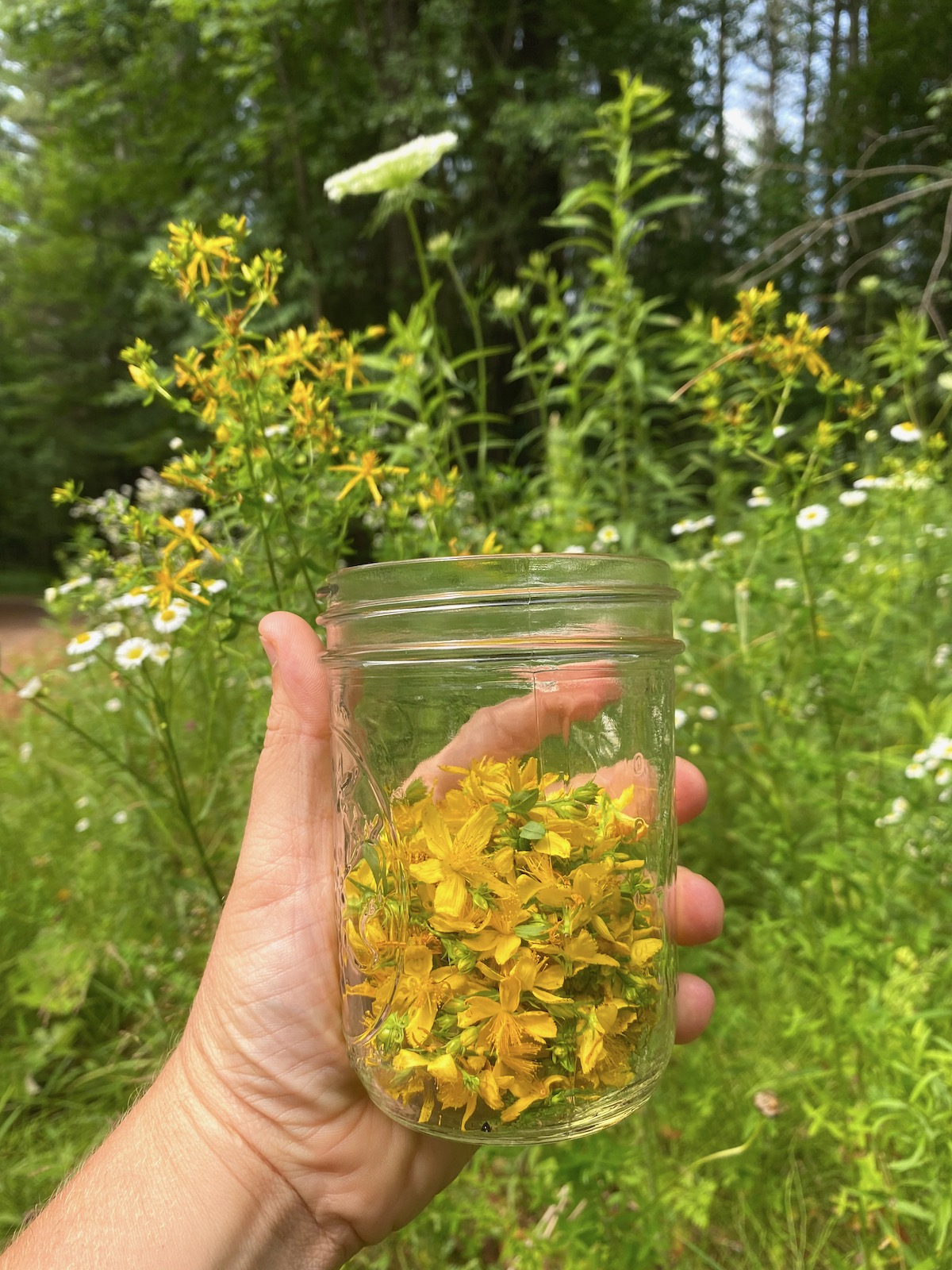
To make the tincture, fill a jar about 2/3rds full with St. John’s Wort flowering tops.
Cover the fresh herb with vodka, or whichever alcohol you’ve chosen, and seal the jar with its lid.
Keep the developing tincture in a cool, dark place and give the jar a gentle shake every few days (daily is even better, but tinctures are, fortunately very forgiving when it comes to precise shaking schedules).
When made with fresh herbs, this particular tincture will turn an amber-red color because of compounds in the fresh St. John’s Wort flowers. (You can actually see the red color create a stain on your hands if you crust a fresh flower between your fingers, and that’s one of the identification characteristics.)
That brown/red color is a good indication of a high-quality St. Johns Wort extract.
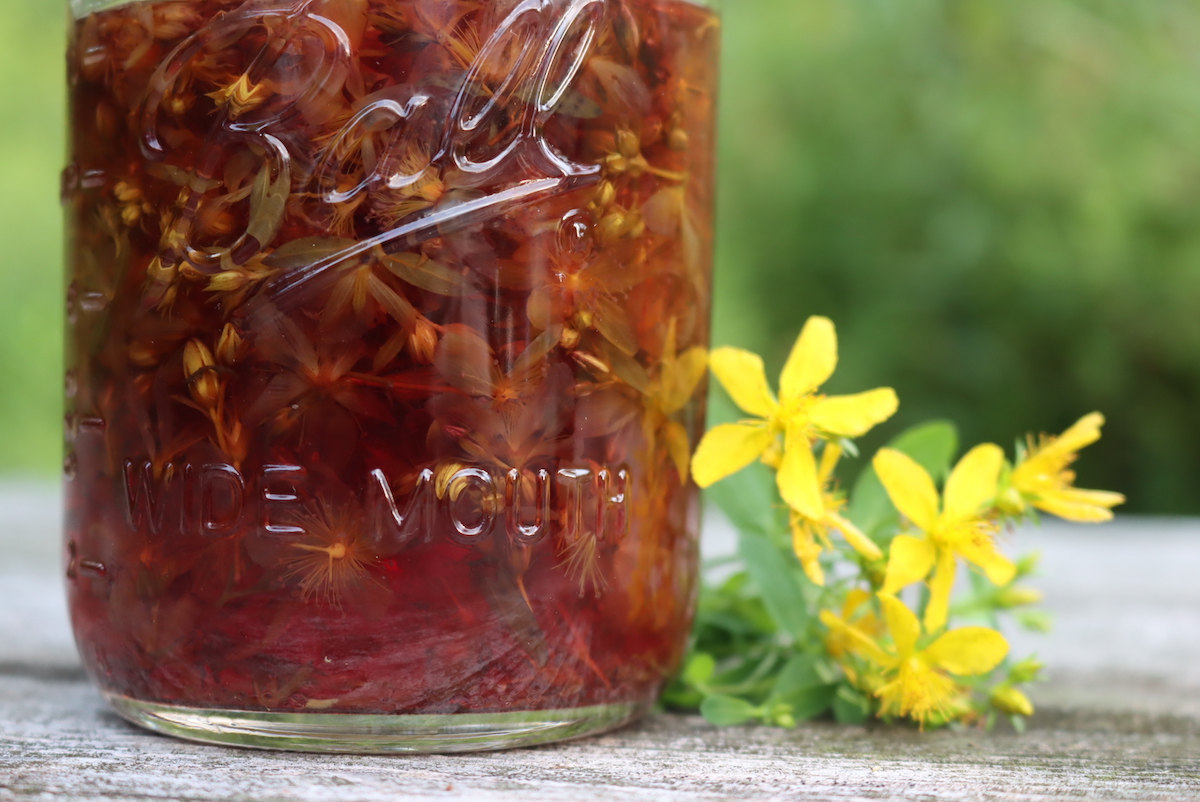
After about 4 to 6 weeks, it’s time to decant the tincture.
To do this, you’ll need to line a funnel with a few layers of cheesecloth. Carefully strain the tincture into small amber glass tincture bottles, squeezing the plant material to make sure all the liquid is expelled.
Once the tincture has been decanted, label the tincture bottles with the date and suggested dosages (I use a small piece of masking tape and a marker, it peels off easily when I’m ready to use the bottle for something else).
For more information on the general process, I’d suggest reading this guide to making herbal tinctures at home.
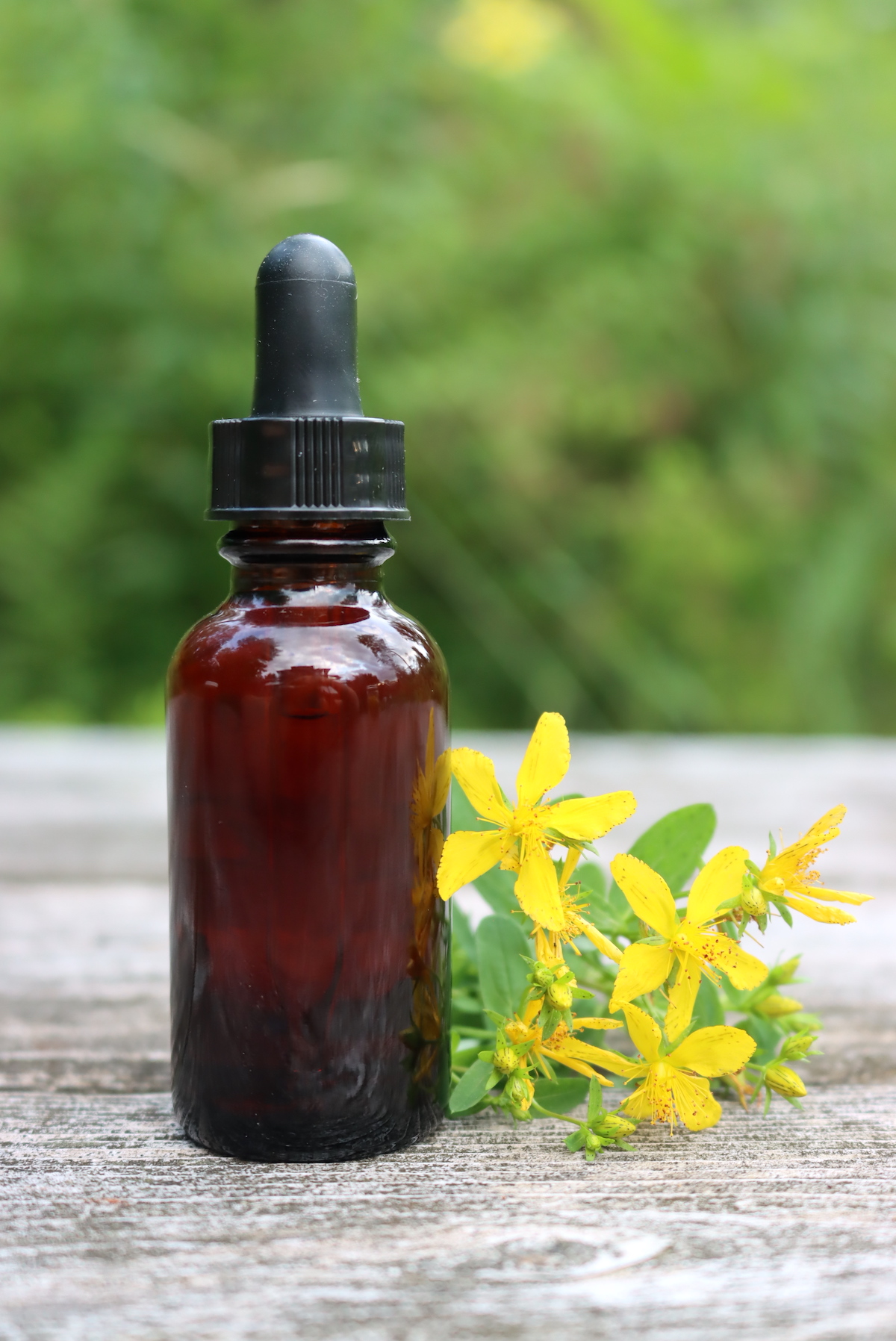
St. John’s Wort Tincture Dosage
For an exact dosage specific to your body and needs, I’d suggest consulting a clinical herbalist or your doctor. (I am not a doctor or clinical herbalist.)
Generally, the dosage for St. John’s Wort tincture is 2 to 4 ml taken up to three times per day. A single “dropper full” in a standard tincture bottle is around 1 ml, and a teaspoon is 5 ml.
Again, be aware that St. Johns Wort has a long list of negative drug interactions, so be sure to consult your doctor especially if you’re taking other medications. It’s also been reported that some people have negative reactions when they’ve been taking St. John’s wort tincture for a while and then suddenly stop, so try to slowly taper off to avoid that (unless advised otherwise by your doctor).

St. John’s Wort Formulations
Generally, I try to provide some options here for combining herbs to increase their effectiveness. For example, in a “better sleep” tincture you could combine valerian tincture and chamomile tincture for complementary effects.
In the case of St. John’s Wort, I’m hesitant to give any such recommendations simply because it can interact negatively with so many other modern medications…it can be tricky to know which herbal medications may (or may not) work well with it.
If you’re interested in the science behind combining herbs to enhance their effectiveness, I’d recommend taking this online course in Mastering Herbal Formulations from the Herbal Academy. It covers the science of blending herbs into homemade formulations in detail.
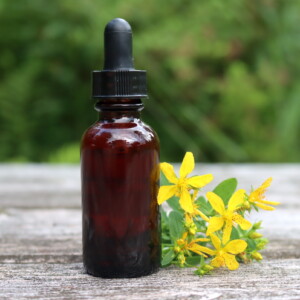
St. Johns Wort Tincture
Equipment
Ingredients
- Fresh St. Johns Wort Flowering Tops
- Vodka or other palatable, neutral alcohol that is 80 proof/40 percent
Instructions
- Add the fresh flowering tops of st. johns wort herb to a mason jar.
- Fill the jar up with alcohol and seal with the lid. Give the jar a gentle shake.
- Store the developing tincture in a cool, dark place; shake the jar every couple of days (or every day, if you can remember).
- Let the tincture develop for 6 to 8 weeks.
- Decant the finished st. john's wort extract by lining the funnel with cheesecloth and straining the liquid into the small tincture bottles.
- Label the tincture bottle with its contents, the date, and suggested dosages. Store in a cool, dark place.
Notes
Disclaimer on Homemade Herbal Remedies
I’ve been foraging wild medicines and treating my family with herbal remedies for the past 20 years, but I’m self-taught. Be aware that I am not a clinical herbalist, and this is based on my own research and personal experience using medicinal plants. I do not claim to have the experience that’d qualify me to advise you on your health, and I’m only providing this as a reference to encourage a broader interest in medicinal plants.
Please use this as a jumping-off point, but always do your own research and verify anything you read with multiple sources.
It’s always possible to have an adverse reaction to any medicinal herb, and plenty of people are allergic to even gentle herbs like chamomile. Always consult your doctor or a certified herbalist before trying any new medicinal plant. Often, they can have unintended reactions in combination with other herbs and supplements, and many herbs have side effects even when they are effective for their intended purpose.
If you are seriously interested in herbal medicine, I’d suggest investing in a course in herbal medicine, and I’d recommend any of the online courses put out by the Herbal Academy of New England. Specifically, the introduction to herbal medicine course and the family herbalist group of courses.
They also have a mushroom course, covering both medicinal and edible mushrooms, and a Botany and Wildcrafting Course. I’ve taken both and they’re informative, inspiring, and artfully presented.
Herbal Tinctures
Interested in making other homemade herbal tinctures?
- Yarrow Tincture
- Chickweed Tincture
- Elderberry Tincture
- Dandelion Tincture
- Burdock Tincture
- Echinacea Tincture
Herbal Medicine Making
Herbal medicines don’t stop at tinctures! Learn how to make more homemade medicine…
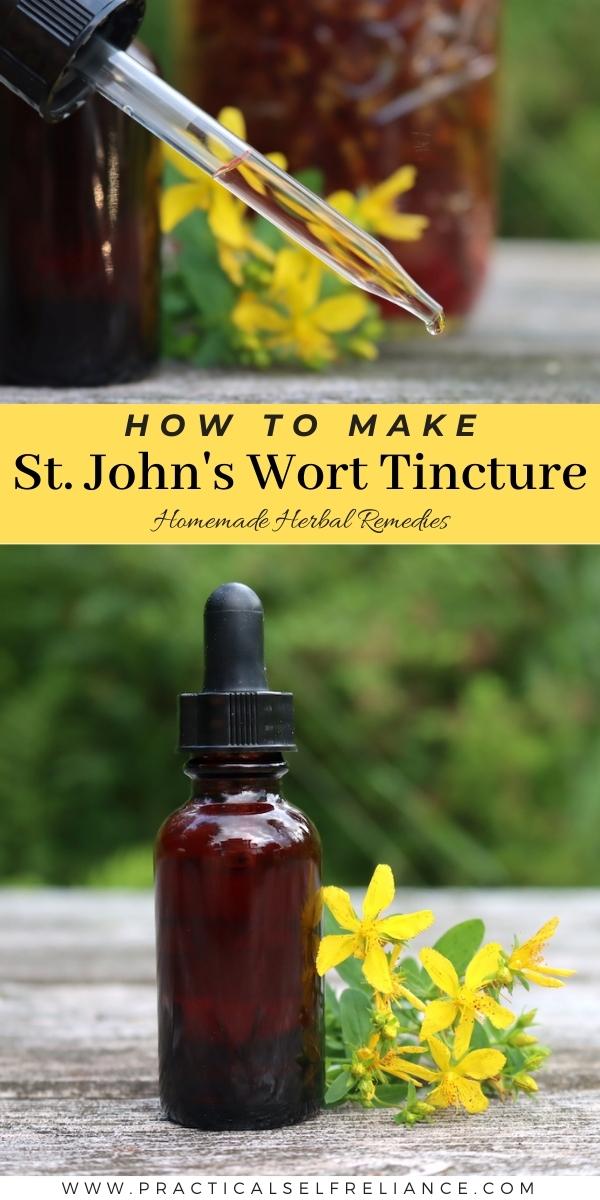
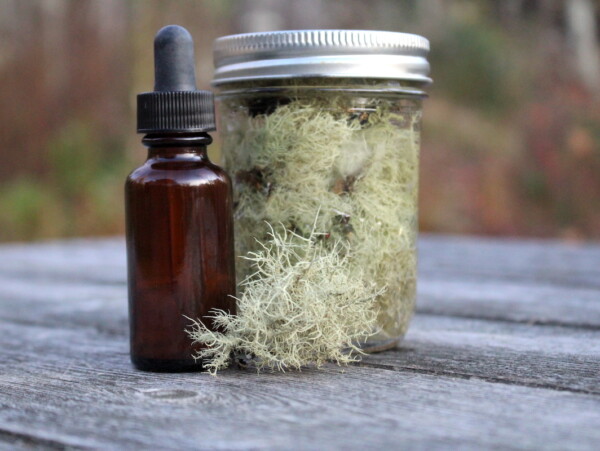
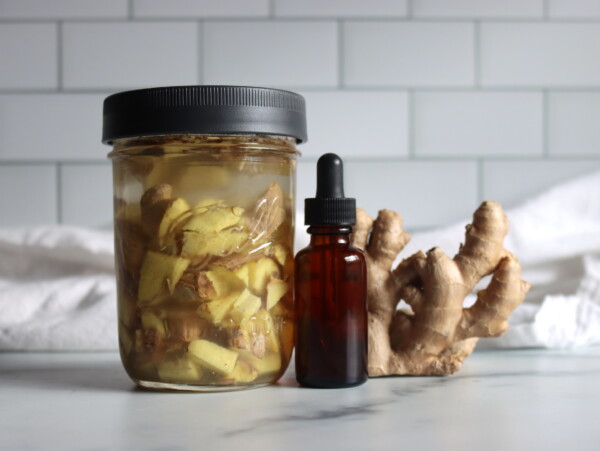
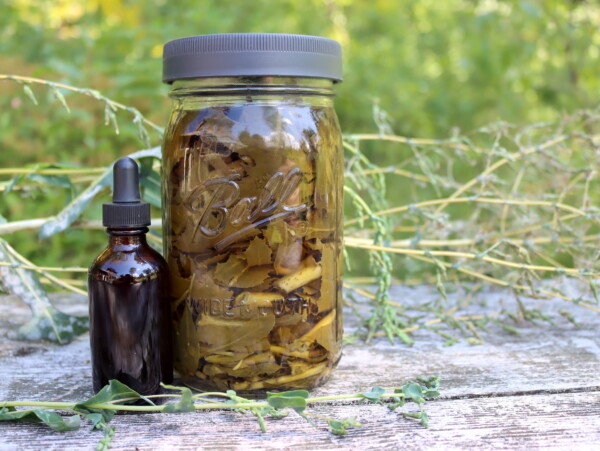
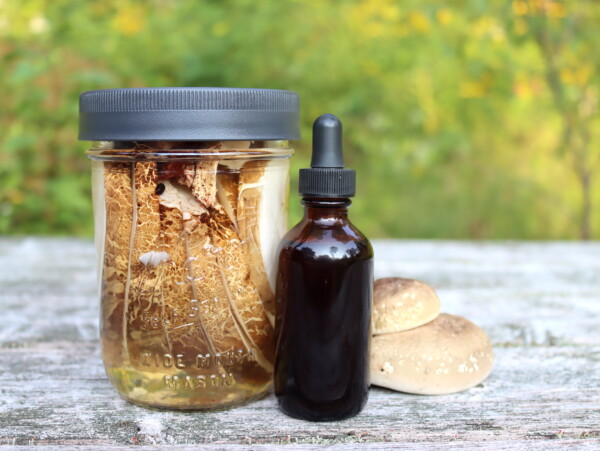










I like how cautions are described and mentioned a few times, whole the recipe itself is given in a simple way. Also happy to finally see a recipe specifying the bed to use fresh St John’s wort!
Thanks!
I am glad that you stress the many serious and life-threatening interactions. This medicine also needs to be tapered up when starting and tapered down when stopping it. Not worse the risks, however, I found that st johnswort works great on muscle pain, I add it to my st johnswort salve for an extra boost. A great herb for topical use.
Thank you so much for sharing. We’re so glad you enjoyed the post.